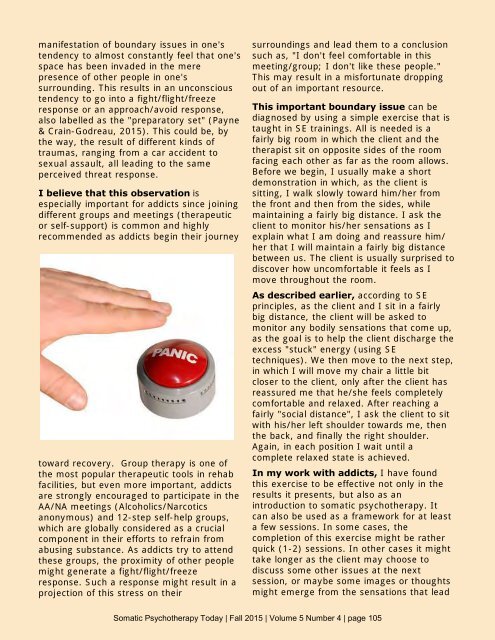Somatic Psychotherapy Today
1RCP3xp
1RCP3xp
Create successful ePaper yourself
Turn your PDF publications into a flip-book with our unique Google optimized e-Paper software.
manifestation of boundary issues in one's<br />
tendency to almost constantly feel that one's<br />
space has been invaded in the mere<br />
presence of other people in one's<br />
surrounding. This results in an unconscious<br />
tendency to go into a fight/flight/freeze<br />
response or an approach/avoid response,<br />
also labelled as the "preparatory set" (Payne<br />
& Crain-Godreau, 2015). This could be, by<br />
the way, the result of different kinds of<br />
traumas, ranging from a car accident to<br />
sexual assault, all leading to the same<br />
perceived threat response.<br />
I believe that this observation is<br />
especially important for addicts since joining<br />
different groups and meetings (therapeutic<br />
or self-support) is common and highly<br />
recommended as addicts begin their journey<br />
toward recovery. Group therapy is one of<br />
the most popular therapeutic tools in rehab<br />
facilities, but even more important, addicts<br />
are strongly encouraged to participate in the<br />
AA/NA meetings (Alcoholics/Narcotics<br />
anonymous) and 12-step self-help groups,<br />
which are globally considered as a crucial<br />
component in their efforts to refrain from<br />
abusing substance. As addicts try to attend<br />
these groups, the proximity of other people<br />
might generate a fight/flight/freeze<br />
response. Such a response might result in a<br />
projection of this stress on their<br />
surroundings and lead them to a conclusion<br />
such as, "I don't feel comfortable in this<br />
meeting/group; I don't like these people."<br />
This may result in a misfortunate dropping<br />
out of an important resource.<br />
This important boundary issue can be<br />
diagnosed by using a simple exercise that is<br />
taught in SE trainings. All is needed is a<br />
fairly big room in which the client and the<br />
therapist sit on opposite sides of the room<br />
facing each other as far as the room allows.<br />
Before we begin, I usually make a short<br />
demonstration in which, as the client is<br />
sitting, I walk slowly toward him/her from<br />
the front and then from the sides, while<br />
maintaining a fairly big distance. I ask the<br />
client to monitor his/her sensations as I<br />
explain what I am doing and reassure him/<br />
her that I will maintain a fairly big distance<br />
between us. The client is usually surprised to<br />
discover how uncomfortable it feels as I<br />
move throughout the room.<br />
As described earlier, according to SE<br />
principles, as the client and I sit in a fairly<br />
big distance, the client will be asked to<br />
monitor any bodily sensations that come up,<br />
as the goal is to help the client discharge the<br />
excess "stuck" energy (using SE<br />
techniques). We then move to the next step,<br />
in which I will move my chair a little bit<br />
closer to the client, only after the client has<br />
reassured me that he/she feels completely<br />
comfortable and relaxed. After reaching a<br />
fairly "social distance", I ask the client to sit<br />
with his/her left shoulder towards me, then<br />
the back, and finally the right shoulder.<br />
Again, in each position I wait until a<br />
complete relaxed state is achieved.<br />
In my work with addicts, I have found<br />
this exercise to be effective not only in the<br />
results it presents, but also as an<br />
introduction to somatic psychotherapy. It<br />
can also be used as a framework for at least<br />
a few sessions. In some cases, the<br />
completion of this exercise might be rather<br />
quick (1-2) sessions. In other cases it might<br />
take longer as the client may choose to<br />
discuss some other issues at the next<br />
session, or maybe some images or thoughts<br />
might emerge from the sensations that lead<br />
<strong>Somatic</strong> <strong>Psychotherapy</strong> <strong>Today</strong> | Fall 2015 | Volume 5 Number 4 | page 105


